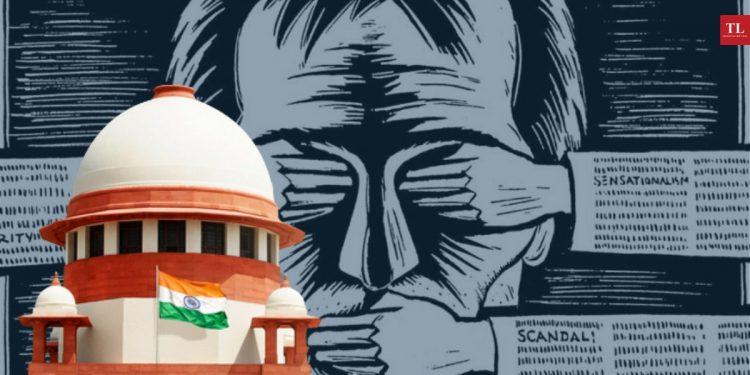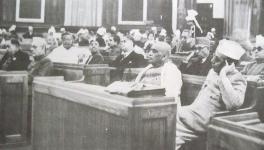Supreme Court Must Course-Correct From its Kedar Nath Singh Ruling

In light of the spate of petitions filed before the Supreme Court challenging the constitutionality of Section 124A of the Indian Penal Code – popularly known as the sedition law – in light of its recent rampant abuse by the government, MD ZEESHAN AHMAD and ZAIN HAIDER make the case for the provision being struck off by the apex court and explain why its Kedar Nath Singh judgment, which prescribes the standards for application of the law, was incorrectly decided.
——
The sedition law is once again under fire. Obviously, for its notoriety for misuse!
This is not for the first time that the sedition law is in the proverbial eye of the storm. The legal history of independent India shows that the sedition law (that is, Section 124A of the Indian Penal Code), owing to its colonial provenance, vague definition, draconian nature of the punishment, and lack of procedural safeguards has been a cause célèbre. Given this, the Law Commission of India, in its 2018 consultation paper on sedition even noted that it is time to re-think or repeal section 124A.
However, ever since the Bharatiya Janta Party-led National Democratic Alliance government came to power in 2014, with its creed of ultra-nationalistic politics, an eerie surge has been witnessed in the number of sedition cases, that too with a low conviction rate. Research by digital webportal Article 14 notes that there has been a 28% increase in cases of sedition filed each year between 2014 and 2020, compared to the yearly average between 2010 and 2014. While the National Crime Records Bureau’s data shows that the conviction rates under the sedition charge in the period of 2016-19 is just 3.3 %.
The agility with which the government responded to the anti-Citizenship Amendment Act and anti-farm laws protestors with bookings under the sedition law highlights its weaponization and the criminalization of speech. Even those who questioned the government’s performance in managing the pandemic have had to face the brunt of the sedition law.
It is against this background that on June 15, 2021, the Supreme Court heard public interest litigation challenging the constitutional validity of the sedition law. The Chief Justice of India N.V. Ramana, while hearing the petition, pointedly asked the Attorney General of India that given the misuse of sedition law, “is this law still required to exist?”
Also read: Decoding the history of Sedition law in India
It is heartening to see that the apex court has risen to the occasion and is batting for the rights of the citizens in posing tough questions before the government. At the same time, it needs to be ensured that amidst the present jubilation, one crucial question does not get missed.
Recent judicial pronouncements on scope of application of sedition law
Why did a need for such intervention from the apex court arise shortly after its judgment in the Vinod Dua case in which it was held that critical analysis of State policy won’t attract sedition? Why didn’t the judgment allay the fear of being embroiled in a sedition case on exercising one’s right to speech?
It is not just the Vinod Dua judgment, but a series of similar judgments whose efficacy comes into question. For instance, in Disha Ravi’s case, while granting her bail in February, a Sessions Court quoted from Niharendu Dutt Mazumdar vs.Emperor (1942) to underscored that “[t]he offence of sedition cannot be invoked to minister to the wounded vanity of the governments”. While in Bilal Ahmad Kaloo vs. State of Andhra Pradesh (1997), the Supreme Court lamented:
“[T]he manner in which convictions have been recorded for offences under Section 153A, 124A and 505(2), has exhibited a very casual approach of the trial court. Let alone the absence of any evidence which may attract the provisions of the sections, as already observed, even the charges framed … did not contain the essential ingredients of the offences under the three sections. The appellant strictly speaking should not have been put to trial for those offences. Mechanical order convicting a citizen for offences of such serious nature as sedition and to promote enmity and hatred etc. does harm to the cause. It is expected that graver the offence, greater should be the care taken so that the liberty of a citizen is not lightly interfered with.”
Also read: The Law of Sedition and Bal Gangadhar Tilak
Despite the above observations by courts, the executive branch of the State has neither appreciated nor adhered to them. This disregard is outrageous and perhaps sinister. Moreover, it demonstrates that the misuse of sedition law is not only curtailing the rights of citizens, but by not adhering to the rights-upholding decisions of the judiciary, the executive has even created judicial mistrust among citizens.
Also read: Non-violent speech and the violent State: Understanding ‘Sedition’ in India
Despite the best efforts by the judiciary in upholding citizens’ rights in cases of sedition, there seems to be a marked inconsistency in the basic understanding and application of the sedition law. This inconsistency owes its genesis to the vague and broad definition of sedition law. The history of the misuse of the sedition law has shown the capitalisation of this vagueness by the successive governments.
The above paradox cannot be understood without shining light on the Supreme Court’s landmark Kedar Nath Singh vs. State of Bihar (1962) judgement. In this case, the constitutional validity of section 124A of IPC was checked.
To understand Kedar Nath Singh and its repercussions on free speech jurisprudence, one must have a sound idea about the first Constitutional amendment in 1951.
Constitution (First Amendment) Act, 1951 – A Legal Sleight of Hand
In the early years of the Indian Republic, the Romesh Thappar and Brij Bhushan cases pertaining to censorship reached the Supreme Court in 1950. While setting aside the censorship in both the cases, the Court said, “freedom of speech and of the press lay at the foundation of all democratic organizations,” and are “essential for the proper functioning of the processes of popular government”. These judgments, however, didn’t go down well with the government of the day.
Also read: Lawmakers Must Examine: Does Free India Need a Sedition Law?
The Indian National Congress-majority Parliament responded by enacting the Constitution (First Amendment) Act, 1951 to dilute these progressive judgments. “Public order”, inter alia, was added to Article 19(2) as an exception to the right to freedom of speech and expression given by Article 19(1) of the Constitution. This move gave short shrift to the reasoning of the Constituent Assembly with regard to Article 19(2), and completely upended the essence of the provision.
Legal scholar Upendra Baxi called the amendment the “second constitution”. Commenting on the 1950s’ contest between freedom and statism over the amendment, academic Pratap Bhanu Mehta notes that “Nehru’s record on free speech is, at moments, cringeworthy”.
The elephant in the room: Kedar Nath Singh judgment
Between 1950 and 1962, three significant judgments on sedition were rendered: Tara Singh Gopi Chand vs. The State (1950) by the Punjab-Haryana High Court and Ram Nandan vs. State (1958) by the Allahabad High Court took the view that with the commencement of the Constitution, section 124A had become void, whereas the Patna High Court in Debi Soren & Ors. vs. The State (1953) upheld its validity.
It is against the above backdrop that the Supreme Court was called upon in Kedar Nath Singh to clear the existing inconsistency.
It is sometimes commented by legal scholars that the Supreme Court missed an opportunity in Kedar Nath Singh to declare section 124A unconstitutional, and that let its misuse be perpetuated. Some even maintain that it was adjudicated on inaccurate grounds, without appreciating the past legal precedent and the constitutional history of India. Do these assessments have any credence?
To begin with, the Supreme Court, while adjudicating the Kedar Nath Singh case, neither paid heed to the text nor to the wisdom of the constituent assembly debates which deleted the word sedition law from the exception of free speech and expression. Independence activist and educationist K.M. Munshi had eloquently said in the Constituent Assembly that “the essence of democracy is criticism of government” because “the advocacy of a different system of Government … gives vitality to a democracy.”
Also read: Sedition law has no place in a democratic society
Second, the court didn’t take into cognizance its own judgment in The Superintendent, Central Prison, Fatehgarh vs. Ram Manohar Lohiya case (1960) which was decided just two years ago, pertaining to the doctrine of proximate nexus test. According to the proximate nexus test, the speech and the ensuing violence should have a proximate nexus, and it should not be farfetched or remote.
However, in Kedar Nath Singh, the court read “intention” or “tendency” to incite violence to be the threshold to invite the application of sedition law. The actual taking place of actual violence vis-à-vis the inciting speech is clearly missing in this judgement. This reasoning is vague, thereby making it grossly arbitrary.
Third, the judgment falls short to clearly explain what specifically constitutes “government established by law” and “state”; this gives further room for the abuse of the law. Taking benefit of this lack of explanation, the sedition law has been systematically used by governments to muzzle protest and criticism.
While the Kedar Nath Singh judgment read down the sedition law to the extent of allowing ‘disapprobation’ and ‘criticism’ of the government until it reaches the threshold of intention or tendency to incite violence, this concession by the court was tactically meant to save the sedition law from being declared unconstitutional, rather than actually addressing its true menace.
Also read: Sedition Law: State of Permanent Emergency?
For, had this approach not been applied, sedition law could not have been brought under the ‘public order’ restriction, as sedition is not an exception under Article 19(2). In both Romesh Thappar and Brij Bhushan, the High Courts had said, in no uncertain terms, that apart from the exceptions under Article 19(2), freedom of speech and expression cannot be restricted on any other ground.
In sum, the Kedar Nath Singh judgment was a sort of hard compromise to save section 124A from getting scrapped outright. By cleverly applying interpretative techniques, the Supreme Court was able to save the sedition law.
Also read: Indian Media versus Indian Judiciary – Contradiction in Representations of Seditions Cases
Alas, it could not do anything about its draconian and anti-people nature, which is inbuilt in the law. This is precisely the reason why despite narrowing the meaning of sedition law in 1962, there is a history of its misuse.
Sedition law, or for that matter the Kedar Nath Singh judgment, is incorrigible. It cannot be tailored by way of interpretation or amendment in any way to bring it in consonance with the Indian constitution. The nature of the law cannot be changed by way of interpretation, and sedition law has an anti-people nature.
The present petitions challenging the constitutional validity of sedition law provide an opportunity to undo the menace of Kedar Nath Singh judgment.
Changing contours of free speech and liberty
The judicial response and attitude, and the consciousness of the citizens towards liberty and free speech have changed significantly over the years. The Shreya Singhal vs. Union of India (2015) judgment holding Section 66A of the Information Technology Act unconstitutional for being violative of Article 19(1)(a) stands as one of the most significant testimonies to the said change.
The apex court, while delineating the difference between the terms “discussion”, “advocacy” and “incitement”, said that it is the latter that is proscribed in relation to freedom of speech and expression, and not the former two.
The reasoning of the judgment was a sort of refined and updated version of what was laid out by the Supreme Court in its S. Rangarajan etc vs. P. Jagjivan Ram (1989) and Balwant Singh & Anr. vs. State of Punjab (1995) judgments, underlining that there has to be a nexus between the speech and actual violence in order to curb speech or attract the charges of sedition.
Also read: Now, Mere Disagreement is Sedition
Given the above free speech jurisprudence trajectory, it can comfortably be argued that Kedar Nath Singh doesn’t pass muster. Therefore, it is anachronistic and antithetical to India’s constitutional vision.
To this, there goes a counterargument that sedition law addresses the issue of ‘security of the state’ which is why it should be retained. This argument, however, is unfounded and unwarranted in the first place, because in India there exist scores of special laws (Unlawful Activities (Prevention) Act, National Security Act, to name just two) and Sections 121-140 of the Indian Penal Code which are well designed to take care of national security concerns.
Hoping Against Hope
Against the above background, one cannot think that there exists any plausible reason whatsoever for India to retain the sedition law. Rather, the presence of sedition law has become a liability on free speech and expression.
Moreover, the recent unabated misuse of the law is denting the quality of our democracy. The independent research institute V-Dem recently describing India as an “electoral autocracy”, observing that “[T]he Modi-led government in India has used laws on sedition [among others] to silence critics.” Doing away with sedition law will certainly help in contain this backsliding of democracy. After all, India cannot afford to see dissent stand in the dock for the exercise of democratic rights.
Even for the judiciary, the scrapping of the sedition law is as necessary as for citizens because amidst the looming judicial mistrust being witnessed of late, it will help in reposing the pristine judicial trust among the citizens. Indeed, it will also disarm the government from the incessant misuse of the sedition law.
(Md Zeeshan Ahmad is a Delhi-based advocate, and Zain Haider is a law graduate from the Aligarh Muslim University. The views expressed are personal.)
Get the latest reports & analysis with people's perspective on Protests, movements & deep analytical videos, discussions of the current affairs in your Telegram app. Subscribe to NewsClick's Telegram channel & get Real-Time updates on stories, as they get published on our website.
























